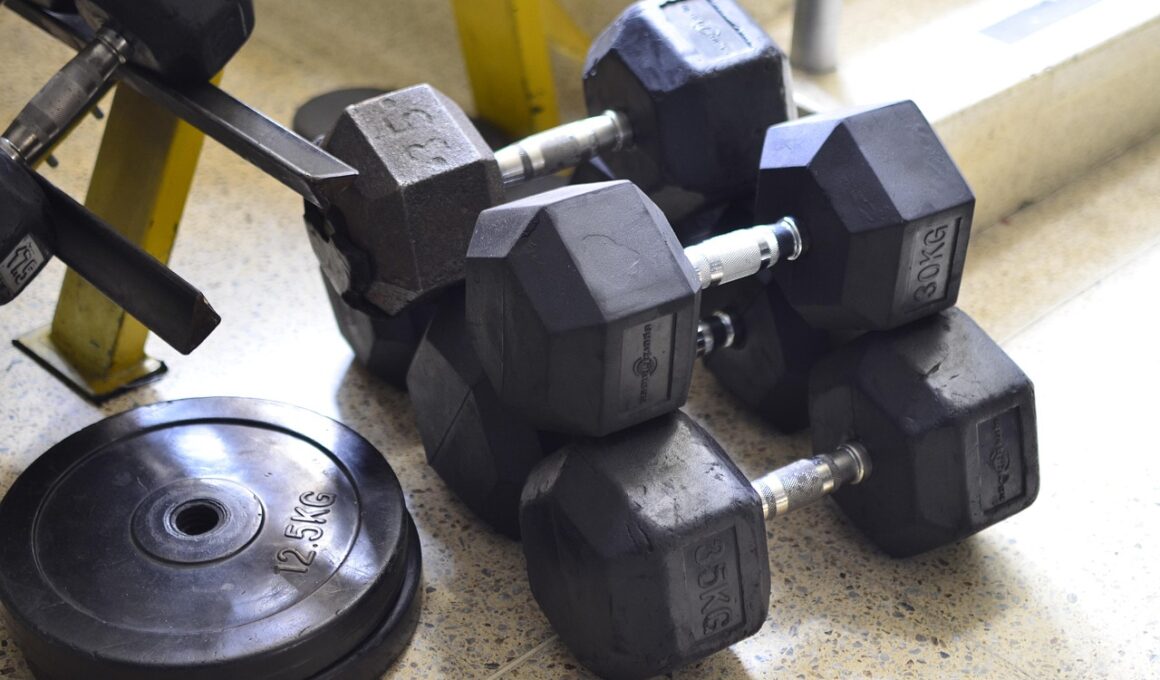Reducing Muscle Fatigue in Extended CrossFit WODs
Muscle fatigue is a common challenge faced by athletes during extended CrossFit workouts. Understanding the physiological aspects of muscle fatigue can empower you to combat its effects effectively. Muscle fatigue typically occurs when muscle fibers become exhausted, leading to diminished performance and increased discomfort. This sensation is often exacerbated during long workouts, especially in high-intensity environments like CrossFit. By implementing advanced techniques, athletes can mitigate the impact of fatigue on performance. Strategies such as proper nutrition, hydration, and recovery practices are crucial. Additionally, incorporating specific warm-up routines and cooldown exercises can significantly improve muscle endurance. It’s essential to focus on mental conditioning, as psychological factors often play a role in perceived fatigue. Techniques like visualization and mindfulness can enhance focus and reduce fatigue perceptions. Lastly, listening to your body is critical. Recognizing signs of fatigue early on allows for appropriate modifications to your workout, ensuring you maintain intensity without sacrificing overall performance. Understanding these elements of muscle fatigue can lead to a more rewarding CrossFit experience.
To reduce muscle fatigue effectively during CrossFit sessions, consider the importance of nutrition. The right nutrition regimen plays a vital role in how your body responds to extended workouts. Consuming the right balance of macronutrients can fuel your muscles, aiding recovery and performance. Focus on a diet rich in lean proteins, healthy fats, and complex carbohydrates, which serve as a strong energy source. For instance, incorporating quinoa, sweet potatoes, and avocados can provide sustained energy levels throughout your workouts. Don’t forget hydration; it is equally crucial. Staying hydrated helps maintain muscle performance and stamina. Consider electrolytes if your workouts are particularly long or intense. Using ready-to-drink sports drinks can expedite recovery. Another aspect to explore is the timing of your meals. Pre-workout meals about 30 minutes prior can promote better endurance and less fatigue. Experimenting with different meal compositions may also lead to discovery of what works best for your body. After training, eating a balanced meal within two hours can fully replenish energy stores and assist muscle recovery, reducing fatigue for your next session. The relationship between nutrition and fatigue cannot be underestimated.
Recovery Techniques for Reducing Fatigue
Incorporating effective recovery methods into your routine is critical for minimizing fatigue during extended CrossFit workouts. Recovery techniques include active recovery, stretching, and foam rolling. Active recovery involves engaging in low-intensity exercise after your main workout session. Activities such as walking or gentle cycling can promote blood flow and reduce soreness. Stretching before and after workouts increases flexibility and helps prevent muscle fatigue. Dynamic stretches prior to exercising prepare the muscles, while static stretches post-workout assist with cooling down. Foam rolling is another recovery strategy that targets muscle knots and enhances blood flow. This self-myofascial release technique alleviates tension built up in the muscle fibers, enhancing recovery. Additionally, adequate sleep is crucial for muscle fatigue reduction. Aim for at least seven hours of quality sleep each night, as this aids the recovery process. More advanced techniques to explore include massage therapy, which promotes relaxation and recovery through various techniques. Regularly incorporating these recovery methods not only enhances performance but also ensures that fatigue does not become a limiting factor in your CrossFit journey.
Listening to your body’s signals should not be overlooked when discussing muscle fatigue. Paying attention to how you feel during workouts is essential for preventing overtraining and fatigue. Each individual’s body responds uniquely to stress and workload; thus, some athletes may need more recovery time than others. Understanding your personal threshold for fatigue allows you to adjust your training plan to prevent burnout. If certain workouts leave you fatigued more than usual, consider modifying them by decreasing intensity or duration. Additionally, integrating variety into your WODs can stimulate different muscle groups, reducing the likelihood of fatigue from repetitive movements. Including lighter weights or varying exercises can also enhance muscle recovery while maintaining workout effectiveness. Periodically assessing your performance can provide insight into your fatigue levels. Keep a training log, noting your energy levels, mood, and performance. This data can help determine patterns and highlight fatigue triggers, allowing you to take proactive measures. This individualized approach will lead to more meaningful workouts and ultimately enhance your overall CrossFit experience.
The Role of Strength Training in Fatigue Management
Incorporating strength training into your CrossFit program can significantly contribute to reducing muscle fatigue in extended WODs. Strength training builds muscle endurance, which is crucial for tackling longer and more intense workouts. Over time, engaging in resistance training enables your muscles to withstand prolonged exertion without succumbing to fatigue. Focus on compound movements like squats, deadlifts, and presses, which engage multiple muscle groups simultaneously. These exercises are particularly effective in building muscle endurance. Start with a structured strength program integrated into your weekly routine, focusing on progressive overload to stimulate muscle growth. Additionally, lighter, high-rep workouts can help cultivate endurance without excessive strain. You can combine strength training with your regular WODs, ensuring that you don’t compromise on cardiovascular conditioning or skill development. Scheduling dedicated strength sessions may decrease fatigue during high-intensity workouts, as having established muscle endurance directly correlates to performance capacity. Balancing strength and conditioning with prudent recovery techniques leads to optimal results, allowing you to push your limits while managing fatigue effectively.
Another crucial factor in managing muscle fatigue during extended CrossFit sessions is the importance of pacing. Understanding how to pace yourself through a workout can significantly impact your endurance and performance. It’s tempting to start strong and maintain that momentum; however, this method can lead to rapid fatigue. Instead, learn to distribute your energy throughout the entire workout by adopting a pacing strategy. Begin each workout at a moderate intensity, allowing your muscles to stave off fatigue for longer durations. Utilize intervals, alternating bursts of higher and lower intensity throughout the WOD. This approach helps maximize output while minimizing fatigue effects. Likewise, practicing breath control can contribute to pacing. Learning to maintain steady breathing lowers heart rates and muscle fatigue, allowing for sustained effort. Additionally, visualizing your workout strategy before starting can mentally prepare you, enhancing your focus and efficiency. Acknowledge the importance of adjusting your expectations during each session based on your fatigue levels. Adapting today’s pace based on yesterday’s workout impacts overall performance positively, creating a sustainable path toward improvement.
Conclusion: Lasting Strategies for Reduced Fatigue
In conclusion, managing muscle fatigue in extended CrossFit sessions is attainable through various methods. By combining nutrition, hydration, adequate recovery, and pacing strategies, you create a comprehensive approach that enhances performance longevity. Strength training should complement your routines, as improved muscle endurance translates directly to better performance. Practicing active recovery techniques also alleviates the effects of fatigue and promotes quicker recovery. Listening to your body is essential; only your body knows your limitations, and adjusting your training to match your capabilities fosters sustainable progress. With these strategies, not only will you reduce muscle fatigue, but you’ll also discover a more enjoyable CrossFit journey. Remember, maintaining proper nutrition and hydration ensures your body performs at optimal levels, further diminishing fatigue. By incorporating strength training into the regimen, you build a robust endurance foundation. Practice pacing for better workout management, allowing you to thrive during intense exercises and elongated WODs. CrossFit is not solely about pushing through; it’s about smart training and health. As you become more attuned to your body, fatigue management will become a seamless part of your training repertoire.
Ultimately, reducing muscle fatigue involves commitment to understanding your body’s needs and responding appropriately. Employ these advanced strategies, and watch as your performance improves and fatigue diminishes over time. Consistency and awareness are key. While no single strategy guarantees instant results, combining multiple approaches will make a meaningful difference. You owe it to your body to maintain a balance between challenge and recovery. This ensures you can enjoy the physical and mental benefits that a CrossFit training regimen provides.


